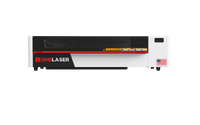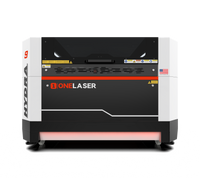The difference in precision and efficiency between a G-code card and a DSP card is mainly reflected in real-time processing, control methods, and the ability to optimize specific applications. The following explains in detail the differences between DSP Controller vs. G-Code Controller and how they work.
Key Takeaway
DSP controllers outperform G-code cards in laser engraving and cutting by delivering higher precision, faster real-time processing, and optimized motion control. While G-code cards offer broad CNC compatibility, their efficiency and accuracy rely heavily on pre-generated files, making them less ideal for complex or high-speed laser tasks. For demanding, detail-oriented projects, DSP controllers are the superior choice.
1. Precision Difference:
The precision of a DSP controller is generally better than that of a G-code card for the following reasons:
a. Real-time Control:
DSP cards use a dedicated digital signal processor that can directly and efficiently communicate with the hardware interface of the laser device in real time. This allows precise control, such as switching the laser on/off and adjusting power or position more accurately.
For example, when adjusting laser power or movement speed, the DSP controller can quickly and precisely manage every laser output detail.

b. Optimized with Dedicated Algorithms:
DSP cards feature built-in control algorithms specifically designed for laser cutting and engraving tasks. These algorithms optimize motion tracking, laser power control, and speed adjustments, ensuring high-precision work without errors. They are especially effective for processing complex patterns and detailed engraving.
c. Adapted to Laser Characteristics:
DSP cards excel in precisely adjusting the laser's cutting or marking path, particularly with high-frequency switching and beam accuracy. This ensures superior results for small engraving details.
In Contrast:
The G-code card, a general-purpose control board, also provides good path control but lacks the real-time processing efficiency of a DSP card. Its accuracy is more reliant on the computer-generated G-code file. Any inaccuracy in the G-code file, such as an insufficiently smooth path, can impact the final results.
2. Efficiency Differences:
DSP cards generally excel in processing speed and efficiency:
a. Lower Latency:
DSP cards' built-in controllers directly process and optimize commands during laser cutting or engraving. This reduces communication delays between the computer and the control board, enabling fast responses and real-time adjustments to the laser's movement and power.
For instance, DSP cards can adjust speed and laser intensity in real time, ensuring even cutting results.
Let's compare the speed performance of the OneLaser XRF and the XTool P2!
Subscribe Our Youtube Channel!
b. Optimized Motion Trajectory:
DSP cards optimize motion paths, minimizing unnecessary movements and reducing acceleration/deceleration delays. This results in smoother operations and avoids efficiency losses from control delays or improper path planning.
In Contrast:
G-code cards rely on pre-generated G-code files, which are processed and executed by the card. These files may lack real-time optimization, leading to delayed processing and lower efficiency, particularly for complex or high-speed tasks.
3. Differences in Principle:
a. DSP Card Principle:
- Hardware Basis: DSP cards feature a dedicated digital signal processor capable of performing advanced mathematical operations and real-time control. They convert design software commands into real-time actions, ensuring precise laser output.
- Dedicated Optimization: DSP systems are optimized for tasks like laser power adjustments, path planning, and high-precision work, making them suitable for complex patterns and high-speed operations.
Related product: LightBurn Pro Version
b. G-Code Card Principle:
- Software Basis: G-code cards use computer-generated text-based instructions to define movement trajectory, speed, feed rate, laser power, and other parameters. The G-code files are generated by software (e.g., CAD/CAM), and the G-code control board reads and executes these instructions to control the device.
- Universal Control: G-code is a universal control language compatible with various CNC equipment, including laser cutting machines, milling machines, and 3D printers. While G-code offers advantages in compatibility and flexibility, it is often less accurate and efficient than DSP cards, especially for laser applications requiring complex path planning and fine control.
4. Summary of DSP Controller vs. G-Code Controller:
a. Accuracy:
DSP cards provide higher accuracy as they are specifically designed for laser equipment and offer optimal real-time control. In contrast, the accuracy of G-code cards depends on the quality of the G-code file and the board's processing speed.
b. Efficiency:
DSP cards are more efficient, enabling real-time control of laser parameters and optimized motion trajectories. G-code cards are less efficient because they rely on an external computer to generate instructions and have slower processing speeds.
c. Differences in Application:
DSP cards are better suited for high-precision tasks, such as laser engraving and cutting complex patterns or high-speed operations. G-code cards are more appropriate for scenarios with lower equipment demands or when a universal control language is needed, such as operating multiple CNC machines of different types simultaneously.
Need the best machine? Talk to our experts!
The DSP controller stands out as the superior choice for tasks requiring high precision, efficiency, and real-time control, especially in laser engraving and cutting applications. With dedicated algorithms and optimized hardware, the DSP controller ensures smooth, accurate operations for complex patterns and high-speed tasks.
While G-code cards offer flexibility and compatibility with various CNC equipment, they fall short in precision and efficiency, making them less ideal for demanding laser applications. For users seeking advanced performance and reliability, the DSP controller proves to be the more effective solution.
FAQs
Q1: Which is more accurate, DSP or G-code?
DSP controllers are generally more accurate thanks to real-time processing and laser-specific optimization.
Q2: Which is faster?
DSP controllers process commands in real time, making them faster and more efficient than G-code cards.
Q3: Can G-code be used for lasers?
Yes, but it’s less precise and efficient compared to DSP, especially for complex or high-speed tasks.
Q4: Which should I choose for laser engraving?
For detailed, high-speed, and complex laser work, a DSP controller is the better choice.
Q5: Why use G-code?
G-code offers flexibility and compatibility with various CNC machines, not just lasers.

 Liquid error (sections/image-banner line 171): invalid url input
Liquid error (sections/image-banner line 171): invalid url input







2 comments
Hi guys
Quick clarification on the controller used in the OneLaser, I did some digging because the article doesn’t explicitly state which type it uses.
Based on OneLaser’s official product specifications:
The OneLaser XT (with a 55 W glass CO₂ tube) is described as using an advanced DSP motion control system. This is highlighted as a significant improvement over traditional G-code systems commonly found in hobby-grade machines
Similarly, the OneLaser XRF (with a 38 W RF metal tube) is also noted to be powered by advanced DSP motion control, emphasizing speed, efficiency, and precision, and positioning it clearly ahead of older G-code-based machines.
So in short: OneLaser machines, both the XT and XRF models, use DSP (Digital Signal Processing) motion control systems, not G-code controllers.
Hope this helps clear things up!
What controller is used on 1Laser? The article does not specify.